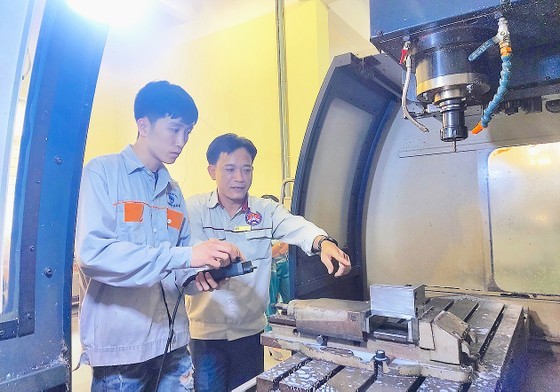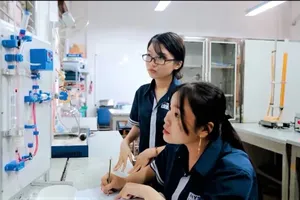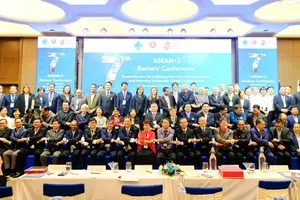 |
A lecturer of a vocaional schools (R) is guiding a student |
Though companies have advertised to recruit many skilled laborers for machine building, turning, metal cutting, CNC milling, and welding each year, companies couldn’t fill their vacant engineering positions as planned. The paradox is that just a few students enroll in vocational schools’ mechanism engineering faculties.
Having just graduated from metal cutting at Ho Chi Minh City Vocational College, Nguyen Anh Van in Hoc Mon outlying district was recruited by a company in Tan Phu Trung Industrial Park with a salary of VND10 million (US$423) a month.
He remembered after completing his military service in 2019, he didn’t know what to do to earn money. Later, realizing that mechanical enterprises in Hoc Mon District needed engineering laborers, he decided to apply for an apprenticeship in metal cutting at Ho Chi Minh City Vocational College. When he was a sophomore, he was recruited by a company. In his opinion, vocational training has many job opportunities.
Similarly, after graduating from CNC milling at Hung Vuong Technical and Technological Intermediate School in District 5, Tran Tieu Phuc was hired by a company in Vinh Loc B Industrial Park with a salary of VND11 million a month.
Mr. Le Long Son, General Director of Esuhai Group, said that at the 2023 International Job and Education Connection Festival organized by Saigon Van Lang College recently, the Group cooperated with about 200 Japanese and Korean enterprises to recruit nearly 5,000 jobs per year. Japanese and Korean companies most needed engineers with college degrees in mechanical engineering whose basic income from VND25 million-VND34 million a month excluding allowances.
He disclosed almost students from machine manufacturing, lathe, metal cutting, CNC milling, and welding faculties are recruited.
According to Principal of Ho Chi Minh City Vocational College Tran Kim Tuyen, the school's enrollment quota for mechanical engineering is about 500 students a year. Students will learn with equipment and machines under CNC (Computerized Numerical Control) technology.
Mechanical engineering students will spend most of their time practicing on CNC machines, lathes. Therefore, they firmly grasp job skills and are recruited by businesses while they are students, said teacher Tran Kim Tuyen.
According to the General Statistics Office, the whole country has about 30,000 mechanical enterprises accounting for nearly 30 percent of the total number of manufacturing and processing industry enterprises. These enterprises each year generate production and business revenue of about US$1.5 million and create over 1.2 million jobs. The number of personnel these enterprises need to supplement every year accounts for 10 percent-28 percent of the total labor demand of the country. However, these enterprises are always short of engineers, and skilled workers in the industries of machine manufacturing, turning, CNC milling, and welding although they posted many recruitment advertisements.
Ho Chi Minh City human resource forecaster Tran Anh Tuan said that there are many reasons leading to the above inadequacy. First, those who are good at vocational skills choose to work abroad in Germany, Japan, and Korea because of their attractive salary, benefits, and improved skills due to access to modern technology.
Secondly, just a few vocational schools are well-invested in purchasing modern equipment for teaching and learning. Some schools still teach and learn on old machinery and equipment from 10-20 years ago, backward in technology.
In addition, one of the reasons why vocational schools couldn't fill their enrolment quota is that many parents thought mechanical engineering jobs were heavy and toxic, so they did not want their children to study. Subsequently, very few students pursue studying mechanism engineering faculty.
Rector of Hung Vuong Technical and Technological Intermediate School Pham Quang Trang Thuy said that in order to recruit professions such as metal cutting and welding, the school managers must have talks with parents encouraging them to let children study. However, enrollment results only reached 50 percent, and some faculties’ enrolment was less than 10 percent of the quota.
Elsewhere in Hanoi, the Industrial Vocational College is famous for the training of mechanical engineering in the capital city, but according to the school management board, the enrollment quota for welding has been very low in the past 5 years. For instance, in 2017, the school had 10 classes with 20-30 students in each class of welding and metal cutting engineering, then in 2019, there were only 2 classes and only 1 class with 15 students in 2022.
In 2023, the school did not register the welding occupation quota because no students wanted to register the faculty, said MSc Nguyen Thu Huong, Rector of the Hanoi Industrial Vocational College.
























